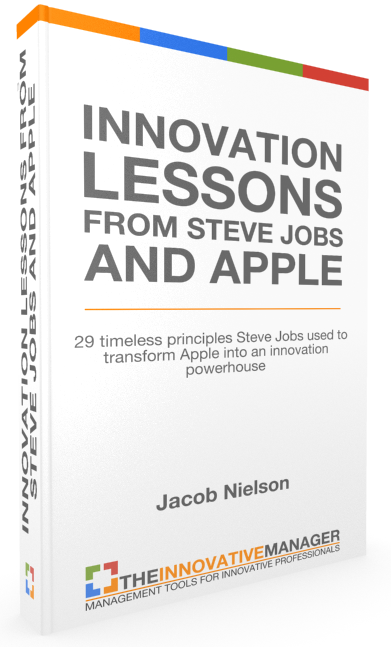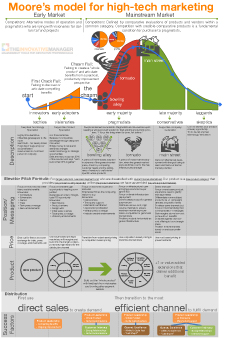Over the next several weeks I’ll be analyzing the innovation lessons learned from Steve Jobs’ tenure at Apple. What better place to start than with the product that saved the struggling company – the iMac.
After Steve Jobs was pushed out of Apple in September 1985, Apple seemed to be caught in a downward spiral. A litany of confused and endlessly proliferated products left Apple losing sales and hemorrhaging cash. By the mid 90’s it seemed Apple’s fate was to suffer a slow death – the inevitable sentence passed upon every large organization that has stopped innovating.
By early 1997, Steve Jobs had rejoined the company as an adviser – part of the terms he agreed to when Apple bought his other startup Next. But despite forging a new partnership with Microsoft and boosting sales of the Power Macintosh, Apple’s future still seemed bleak. To further rub salt in Apple’s wounds, on October 6, 1997 Michael Dell said the following in response to a question about how to solve Apple’s problems:

FREE VIDEO TRAINING FOR INNOVATORS
Over 100 Slides Free and Downloadable as a PDF
“What would I do? I’d shut it down and give the money back to the shareholders,” – Michael Dell, October 1997
Despite the bleak assessment from Michael Dell (and the irony that later on Dell would eat those words), the seeds of Apple’s revival were planted earlier that year in a product review meeting when, after being frustrated and confused by the dizzying array of products Apple was making at the time, Jobs took a marker and drew a two-by-two grid with the top columns labeled “Desktop” and “Portable” and the other side labeled “Consumer” and “Pro.” “Here’s what we need,” he said, their job was to make four great products, one for each quadrant. All other products would be killed.
Innovation Lesson Number One: Focus
As with the iMac, great innovations require great focus. Even the best engineers in the world won’t create the next best thing if their efforts are diluted by saying yes to everything. That’s why Steve Jobs was famous for saying this about focus:
“People think focus means saying yes to the thing you’ve got to focus on. But that’s not what it means at all. It means saying no to the hundred other good ideas that there are. You have to pick carefully. I’m actually as proud of the things we haven’t done as the things I have done. Innovation is saying no to 1,000 things.” – Steve Jobs
A major reason Apple was failing during Jobs’ absence was because then CEO Gil Amelio had said yes to a 1,000 things.
One of the best stories of how Jobs exemplified saying no to a 1,000 things was the decision to not include a 1.44MB floppy disk drive in the new iMac and instead rely solely on a CD Rom drive for loading files and applications. At the time, this was considered by many, including this LA Times reviewer, to be a major gamble for Apple.
But eventually the gamble paid off because the simplicity and relatively low-cost design of the iMac won consumers over. And most eventually forgot the iMac didn’t have a floppy disk drive simply because software makers had made the shift to selling software on 700+MB CD’s rather than stacks of 1.44MB floppy drives. Those few consumers who insisted on the need for a floppy drive could buy a third-party drive and plug it into the iMac via USB.
The inclusion of only a CD drive leads to another innovation lesson from Steve Jobs, namely skating where the puck is going.
Innovation Lesson Number Two: Skate to Where the Puck Is Going, Not Where It’s Been
Steve Jobs loved this quote by the hockey great Wayne Gretzky
“I skate to where the puck is going to be, not where it has been.” – Wayne Gretzky
Truth be told, by 1998 most people only used floppy disk drives for transferring their own files to and from other computers. By the time the iMac launched, email attachments had resolved most issues with transferring files between computers. And from Jobs’ perspective, putting a floppy drive on the iMac would have been a compromise to accommodate the past. Instead, he wanted his products to represent the future.
Innovation Lesson Number Three: Simplicity Is the Ultimate Form of Sophistication
When it came to the design of the iMac – and remember that design to Steve Jobs was much more than just the veneer – simplicity and ease of use was the constant rallying cry. Jobs had preached this philosophy since way back in 1983 when at a design conference in Aspen (full audio can be found here) he said:
“What we’re going to do is make the products high-tech, and we’re going to package them cleanly so that you know they’re high-tech. We will fit them in a small package, and then we can make them beautiful…just like Braun does with its electronics.
We will make them bright and pure and honest about being high-tech, rather than a heavy industrial look of black…like Sony.”
So that’s our approach. Very simple, and we’re really shooting for Museum of Modern Art quality. The way we’re running the company, the product design, the advertising, it all comes down to this: Let’s make it simple. Really simple.” – Steve Jobs
With these as guiding principles for Apple, when Jony Ive proposed the vibrant colors, integrated design and translucent case of the iMac, Steve Jobs approved and defended the unique design up until the launch.
In Walter Isaacson’s biography, Steve Jobs, he quotes Ive as recalling that experience…
“Back then, people weren’t comfortable with technology. If you’re scared of something, then you won’t touch it…so I thought, if there’s this handle on it, it makes a relationship possible. It’s approachable. It’s intuitive. It gives you permission to touch. It gives a sense of its deference to you. Unfortunately, manufacturing a recessed handle costs a lot of money. At the old Apple, I would have lost the argument. What was really great about Steve is that he saw it and said, “That’s cool!” I didn’t explain all the thinking, but he intuitively got it. He just knew that it was part of the iMac’s friendliness and playfulness.” – Jony Ive
One reason Ive was able to come up with such a unique design was thanks to his schooling in industrial design and his experience learning from the legendary Dieter Rams at Braun – the same Braun that Jobs mentioned in the earlier quote. Because Ive’s designs and Rams principles behind them were so integral to the success of the iMac (and all successful Apple products), I’ll let them do the talking by including the video of them below:
3:30 is where the iMac is mentioned.
A link to more on Dieter Rams and his ten principles for good design can be found here.
The power of these simple designs not only had to do with aesthetics but also provided users tremendous benefits in terms of setup and use of the iMac. One of the early commercials for the iMac touted these functional and time-saving benefits by comparing the time it took to setup an iMac versus the time it took to setup a new PC.
The commercial is below:
With a unique, all-in-one design that was simple and easy to use, the iMac made a clear statement against the traditional PC industry: simplicity is the ultimate form of sophistication.
Innovation Lesson Number Four: Controlling The Entire Widget (i.e. Benefit Leadership and Vertical Integration)
When it comes to innovation and business strategy, in general there are two directions a company can go – provide superior benefit leadership or superior cost leadership (I wrote about this here). Both can be successful depending on what the market values most at the time – reduced costs or added benefits. Steve Jobs’ philosophy on this was to always be a benefit leader and let the costs land where they may. The iMac was no different and despite it’s relatively reasonable introductory price, the extra manufacturing costs associated with the translucent case and addition of a built-in handle were a perfect example of Jobs’ benefits first, costs second product management style.
In order to be a benefit leader it helps if your company is vertically integrated – or at least heavily involved in creation of all the parts that go into the product. For example, when the iMac came out it’s unique design was something only Apple could realistically do. Dell, HP and others took off-the-shelf parts from various suppliers to assemble their computers. Microsoft was only interested in providing software at the time and NEC or Viewsonic were separately supplying screens as a standalone product.
This quote, despite being in reference to the Macbook Air, is a perfect example of Jobs’ preaching this philosophy:
“There’s no other company that could make a MacBook Air and the reason is that not only do we control the hardware, but we control the operating system. And it is the intimate interaction between the operating system and the hardware that allows us to do that. There is no intimate interaction between Windows and a Dell notebook.” – Steve Jobs
It was the iMac that started an industry sea change that would favor Apple and vertically integrated products. A trend that continues up until this day. Because only a vertically integrated company like Apple would have dared create their next series of blockbuster successes – the iPod, iPhone and iPad.
Conclusion
The iMac was made available for sale in August 1998 for $1,299. In its first six weeks it sold 278,000 units. By the end of 1998, the iMac racked up sales of 800,000 units – the fastest-selling computer in Apple history.
Following success of the original iMac, Apple introduced updated versions that used flat-panel LCD displays while still holding true to the friendliness and all-in-one design that set the computers apart from the competition.




















One Response to "Innovation Lessons From Steve Jobs And Apple: Story of the iMac"